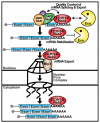Links between mRNA splicing, mRNA quality control, and intellectual disability
- PMID: 27868086
- PMCID: PMC5113822
Links between mRNA splicing, mRNA quality control, and intellectual disability
Abstract
In recent years, the impairment of RNA binding proteins that play key roles in the post-transcriptional regulation of gene expression has been linked to numerous neurological diseases. These RNA binding proteins perform critical mRNA processing steps in the nucleus, including splicing, polyadenylation, and export. In many cases, these RNA binding proteins are ubiquitously expressed raising key questions about why only brain function is impaired. Recently, mutations in the ZC3H14 gene, encoding an evolutionarily conserved, polyadenosine RNA binding protein, have been linked to a nonsyndromic form of autosomal recessive intellectual disability. Thus far, research on ZC3H14 and its Nab2 orthologs in budding yeast and Drosophila reveals that ZC3H14/Nab2 is important for mRNA processing and neuronal patterning. Two recent studies now provide evidence that ZC3H14/Nab2 may function in the quality control of mRNA splicing and export and could help to explain the molecular defects that cause neuronal dysfunction and lead to an inherited form of intellectual disability. These studies on ZC3H14/Nab2 reveal new clues to the puzzle of why loss of the ubiquitously expressed ZC3H14 protein specifically affects neurons.
Figures


Similar articles
-
A conserved role for the zinc finger polyadenosine RNA binding protein, ZC3H14, in control of poly(A) tail length.RNA. 2014 May;20(5):681-8. doi: 10.1261/rna.043984.113. Epub 2014 Mar 26. RNA. 2014. PMID: 24671764 Free PMC article.
-
New kid on the ID block: neural functions of the Nab2/ZC3H14 class of Cys₃His tandem zinc-finger polyadenosine RNA binding proteins.RNA Biol. 2012 May;9(5):555-62. doi: 10.4161/rna.20187. Epub 2012 May 1. RNA Biol. 2012. PMID: 22614829 Free PMC article.
-
The Polyadenosine RNA-binding Protein, Zinc Finger Cys3His Protein 14 (ZC3H14), Regulates the Pre-mRNA Processing of a Key ATP Synthase Subunit mRNA.J Biol Chem. 2016 Oct 21;291(43):22442-22459. doi: 10.1074/jbc.M116.754069. Epub 2016 Aug 25. J Biol Chem. 2016. PMID: 27563065 Free PMC article.
-
The long and the short of it: the role of the zinc finger polyadenosine RNA binding protein, Nab2, in control of poly(A) tail length.Biochim Biophys Acta. 2012 Jun;1819(6):546-54. doi: 10.1016/j.bbagrm.2012.03.006. Epub 2012 Mar 28. Biochim Biophys Acta. 2012. PMID: 22484098 Free PMC article. Review.
-
Structure-function relationships in the Nab2 polyadenosine-RNA binding Zn finger protein family.Protein Sci. 2019 Mar;28(3):513-523. doi: 10.1002/pro.3565. Epub 2019 Jan 16. Protein Sci. 2019. PMID: 30578643 Free PMC article. Review.
Cited by
-
A Genetic Screen Links the Disease-Associated Nab2 RNA-Binding Protein to the Planar Cell Polarity Pathway in Drosophila melanogaster.G3 (Bethesda). 2020 Oct 5;10(10):3575-3583. doi: 10.1534/g3.120.401637. G3 (Bethesda). 2020. PMID: 32817074 Free PMC article.
-
Nuclear mRNA decay: regulatory networks that control gene expression.Nat Rev Genet. 2024 Oct;25(10):679-697. doi: 10.1038/s41576-024-00712-2. Epub 2024 Apr 18. Nat Rev Genet. 2024. PMID: 38637632 Free PMC article. Review.
-
Quality control of mRNAs at the entry of the nuclear pore: Cooperation in a complex molecular system.Nucleus. 2018 Jan 1;9(1):202-211. doi: 10.1080/19491034.2018.1439304. Nucleus. 2018. PMID: 29431587 Free PMC article. Review.
-
Defenders of the Transcriptome: Guard Protein-Mediated mRNA Quality Control in Saccharomyces cerevisiae.Int J Mol Sci. 2024 Sep 24;25(19):10241. doi: 10.3390/ijms251910241. Int J Mol Sci. 2024. PMID: 39408571 Free PMC article. Review.
-
The interplay between transcription and mRNA degradation in Saccharomyces cerevisiae.Microb Cell. 2017 Jul 3;4(7):212-228. doi: 10.15698/mic2017.07.580. Microb Cell. 2017. PMID: 28706937 Free PMC article. Review.
References
-
- Vissers LE, Gilissen C, Veltman JA. Genetic studies in intellectual disability and related disorders. Nat Rev Genet. 2016;17:9–18. - PubMed
-
- Ellison JW, Rosenfeld JA, Shaffer LG. Genetic basis of intellectual disability. Annu Rev Med. 2013;64:441–450. - PubMed
-
- Maulik PK, Mascarenhas MN, Mathers CD, Dua T, Saxena S. Prevalence of intellectual disability: a meta-analysis of population-based studies. Res Dev Disabil. 2011;32:419–436. - PubMed
-
- Leonard H, Wen X. The epidemiology of mental retardation: challenges and opportunities in the new millennium. Ment Retard Dev Disabil Res Rev. 2002;8:117–134. - PubMed
Grants and funding
LinkOut - more resources
Full Text Sources
Molecular Biology Databases
